 |
| Number 55, January-February 2004 |
 |
| Recipe for a supernova |
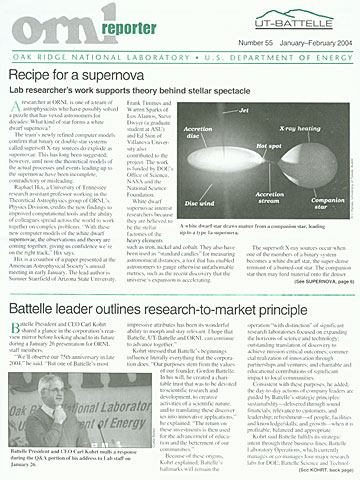 |
| Lab Notes |
|
|
|
|
|
|
|
|
|
|
|
|
|
|
Boys Club, other programs to benefit from UT-B corporate gifts |
|
 Recipe for a supernova
Recipe for a supernova
Lab researcher’s work supports theory behind stellar spectacle
 |
| A white dwarf star draws matter from a companion star, leading up to a type 1a supernova. |
A researcher at ORNL is one of a team of astrophysicists who have possibly solved a puzzle that has vexed astronomers for decades: What kind of star forms a white dwarf supernova?
The team’s newly refined computer models confirm that binary or double-star systems called supersoft X-ray sources do explode as supernovae. This has long been suggested; however, until now the theoretical models of the actual processes and events leading up to the supernovae have been incomplete, contradictory or misleading.
Raphael Hix, a University of Tennessee research assistant professor working in the Theoretical Astrophysics group of ORNL’s Physics Division, credits the new findings to improved computational tools and the ability of colleagues spread across the world to work together on complex problems. “With these new computer models of the white dwarf supernovae, the observations and theory are coming together, giving us confidence we’re on the right track,” Hix says.
Hix is a coauthor of a paper presented at the American Astrophysical Society’s annual meeting in early January. The lead author is Sumner Starrfield of Arizona State University. Frank Timmes and Warren Sparks of Los Alamos, Steve Dwyer (a graduate student at ASU) and Ed Sion of Villanova University also contributed to the project. The work is funded by DOE’s Office of Science, NASA and the National Science Foundation.
White dwarf supernovae interest researchers because they are believed to be the stellar factories of the heavy elements such as iron, nickel and cobalt. They also have been used as “standard candles” for measuring astronomical distances, a tool that has enabled astronomers to gauge otherwise unfathomable metrics, such as the recent discovery that the universe’s expansion is accelerating.
The supersoft X-ray sources occur when one of the members of a binary system becomes a white dwarf star, the super-dense remnant of a burned-out star. The companion star then may feed material onto the denser star. Ordinarily, this material, rich in hydrogen and helium, accretes unburned onto the adjoining white dwarf. This accreted layer erupts at intervals as a classical nova, which Hix says are “fairly common in our galaxy, perhaps 30 every year.” However, these new simulations show how a white dwarf may accrete material until the entire star eventually explodes—a stellar thermonuclear bomb.
| The supernova project came “out of the blue.” |
“Any star up to 8 to10 times the mass of our sun ends up as a white dwarf,” Hix says. “But only those in binary systems can produce novae or white dwarf supernovae. The observations by the Roentgen X-ray Satellite in the early 1990s showed the existence of quite a number of these binary supersoft X-ray sources.”
Researchers, however, were puzzled as to what kept the infalling hydrogen from fusing into helium on the surface of the star and ejecting its mass little by little in nova outbursts instead of building up for the final blast. The new computer models, supported by experiments at the Holifield Radioactive Ion Beam Facility, confirm how the white dwarf, after it’s been heated by a typical nova outburst, can accrete the material in a continuous burn, becoming increasingly dense until it reaches the physical point of no return and explodes into a white dwarf supernova, one of the universe’s most incredible spectacles.
“The belief has long been that the high accretion rates in a white dwarf being fed would burn hydrogen continuously and lead up to the supernova. The problem has been that the existing models grew the white dwarfs but didn’t look like supersoft X-ray sources, or vice versa. With the new simulations, we’re getting accretion rates that look like what we observe,” Hix says.
He and the Physics Division’s Tony Mezzacappa have worked with ASU’s Starrfield often, but the supernova project came “out of the blue.” Starrfield contacted Hix because he needed more expertise on thermonuclear burning.
| As these models grow in complexity, even with 100-teraflop computing we could easily use machines that are faster. |
The new computational modeling capabilities mean that current codes can be expanded to simulate the synthesis of heavier elements in supernovae.
“It looks to us that these models not only produce carbon and oxygen, but also heavier elements,” Hix says. “Dr. Starrfield’s code currently stops at neon. We need to extend it beyond calcium so that we can better compare to the observations.”
He says that astrophysical modeling bridges the gap between astronomical observation and lab experiments, such as those by the Experimental Astrophysics group using the Holifield Facility, where its radioactive ion beams remain a unique tool for astrophysicists. As the researchers simulate more complex systems, the models will continue to tax the capabilities of supercomputers. While much of this work was done using spherically symmetric models on a single processor, other, more complex models have been run on ORNL’s Eagle and Cheetah supercomputers.
“Computational astrophysics is one of the most computationally challenging topics. We are just beginning to model stars as three-dimensional objects, and binary star systems add even more complexity. As these models grow in complexity, even with 100-teraflop computing we could easily use machines that are faster.”
Hix, with collaborators around the country and schooling at the University of Maryland, Harvard and the University of Texas, is doing science at ORNL and UT partly because of what is offered through the mix of the Laboratory’s supercomputing capabilities, the Holifield Facility, and a rich history in physics research.
“Oak Ridge is a unique place to do nuclear astrophysics. There’s a long tradition in nuclear physics, evidenced today in the Holifield facility, but also a growing strength in computational astrophysics,” he said. “As far as the practical value of what we do, it may be as much art as science, but understanding what is happening above us in the sky we see every night is certainly one of man’s oldest preoccupations.”—Bill Cabage
 Battelle leader outlines research-to-market principle
Battelle leader outlines research-to-market principle
Battelle President and CEO Carl Kohrt shared a glance in the corporation’s rear-view mirror before looking ahead to its future during a January 26 presentation for ORNL staff members.
“We’ll observe our 75th anniversary in late 2004,” he said. “But one of Battelle’s most impressive attributes has been its wonderful ability to morph and stay relevant. I hope that Battelle, UT-Battelle and ORNL can continue to advance together.”
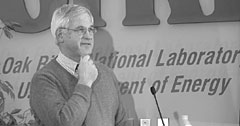 |
| Battelle President and CEO Carl Kohrt mulls a response during the Q&A portion of his address to Lab staff on January 26. |
Kohrt stressed that Battelle’s beginnings influence literally everything that the corporation does. “Our purposes stem from the values of our founder, Gordon Battelle. In his will, he created a charitable trust that was to be devoted to scientific research and development, to creative activities of a scientific nature, and to translating these discoveries into innovative applications,” he explained. “The return on these investments is then used for the advancement of education and the betterment of our communities.”
Because of these origins, Kohrt explained, Battelle’s hallmarks will remain the operation “with distinction” of significant research laboratories focused on expanding the horizons of science and technology; outstanding translation of discovery to achieve mission-critical outcomes; commercial realization of innovation through partnerships and ventures; and charitable and educational contributions of significant impact to local communities.
Consistent with these purposes, he added, the day-to-day actions of company leaders are guided by Battelle’s strategic principles: sustainability—delivered through sound financials, relevance to customers, and leadership; refreshment—of people, facilities and knowledge/skills; and growth—when it is profitable, balanced and appropriate.
Kohrt said Battelle fulfills its strategic intent through three business lines, Battelle Laboratory Operations, which currently manages or co-manages four major research labs for DOE; Battelle Science and Technology International, a premier supplier of technology solutions and support; and Battelle Venture Partners, which translates technology into commercial applications.
Profits from these businesses are reinvested in science and technology and distributed to charitable organizations that focus on the needs of local communities, with a major emphasis on education. Kohrt cited the support for science labs at many East Tennessee schools and the current effort to improve the facilities at Oak Ridge High School as prime examples of this emphasis by the corporation.
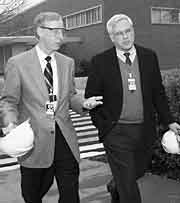 |
| Deputy Director for Science and Technology Lee Riedinger (left) and Kohrt confer during a construction tour. |
He also discussed how Battelle’s integrated science and technology and business strategies help to generate the company’s “signatures,” which include work in homeland security, national defense, energy and environment, advanced materials, transportation and space and health and life sciences. Kohrt added that Battelle’s management of R&D labs helps the company fulfill its founding purpose through the access to cutting-edge research, equipment and staff; the enhancement of its reputation in the scientific community; the ability to earn financial returns for reinvestment; and the opportunity to acquire valuable intellectual property. “It’s not really about the M&O [management and operation] fee,” he said.
Kohrt stressed UT-Battelle’s high expectations for ORNL. “We want it to be the world’s best laboratory,” he said. “This, of course, means we must adhere to our three-part agenda of excellence in science and technology; in laboratory operations and environment, safety and health; and in community service.”
He said UT-Battelle is demonstrating its commitment to delivering on the agenda through the successful efforts to obtain private and state funding for new facilities; advocacy for neutron science, computing, biology, homeland security and other ORNL initiatives; expanded research opportunities through partnerships with core universities, other labs and Battelle; management systems designed to improve efficiency, reduce cost and better support R&D; and legacy investments in education, the community and economic development.
Battelle also is making science and technology investments in areas relevant to ORNL, including non-carbon-based energy technologies, bio-based materials, self-assembled nanophase materials and chem-bio-rad detection for homeland security. The goals, Kohrt explained, are to build signature capabilities relevant to customers’ most critical needs and to increase dollar flow to fulfill the company’s founding purposes. Potential opportunities include Battelle investment in ORNL capabilities, strategic collaborations with other labs and participation in major programs with new customers.
Kohrt said Battelle Ventures, a $150 million venture fund intended to provide a pathway to commercialization for lab-based and other promising innovations, also will provide opportunities for ORNL. These are expected to include expert advice on commercialization potential and strategy, investments in technology maturation, and discretionary income from venture returns. Staff in ORNL’s Technology Transfer and Economic Development directorate are working closely with the Battelle Ventures team.
Other new opportunities for development and commercialization of Lab technologies are expected to come from Privately Funded Tech Transfer, which would give ORNL researchers access to third-party funds for technology maturation and commercialization. Kohrt said these new approaches could result in increased funding for technology maturation and exploitation; discretionary income from financial returns; advancement of DOE missions through accelerated adoption of new technologies; stronger partnerships with the private sector; and the ability to compete for programs with private-sector partners.
Kohrt closed by stressing that Battelle’s management of the national laboratories is “absolutely critical” to the company and will continue to be in the coming years.
Before leaving ORNL, he toured the JICS/ORCAS construction site and met with media representatives from the Knoxville News Sentinel and the Oak Ridger.—Cindy Lundy
 ORNL retiree visits old friend: The Graphite Reactor
ORNL retiree visits old friend: The Graphite Reactor
ORNL retiree and nuclear pioneer Grace McCammon Estabrook played a unique role while working at the Graphite Reactor, now a National Historic Landmark. During the Manhattan Project and immediately afterward, Estabrook—one of the few female mathematicians hired at that time—had a chance to work at both the Y-12 Plant and ORNL.
| Estabrook had the opportunity to sample several of the era’s housing options. |
In 1944, she was hired by Tennessee Eastman to work as an accounting clerk and statistician at Y-12. When she moved to ORNL (known then as Clinton Laboratories) in 1946 to work for Monsanto, she was able to use both her math and physics skills. As an associate physicist in the Physics Division, she used a thermal column in the Graphite Reactor and Bulk Shielding Reactor as her research tools. Using gold and indium as radiation-detection monitors, she performed reactor calculations and measurements involving radiation levels, neutron flux monitoring and attenuations in graphite, beryllium, and water-moderated reactors. Her relationship with the reactor was so novel that a separate graphite pile used for studies through the use of foils was called “Pinky’s Pile”—so named because she had supervised the building of this small pile and because of her red hair.
A native of Maryville, Estabrook earned a B.S. degree with a math major from Maryville College in 1941. While teaching high school math, she was contacted by GM Corporation to come to work for them. Although she decided instead to attend the University of Tennessee to pursue a master’s degree in accounting, statistics and economics, she had identified two good companies to work for in her preferred geographic region–GM and Eastman Kodak. She eventually accepted an offer from Tennessee Eastman so she could work in Oak Ridge—much closer to home—while her brother was away in the service.
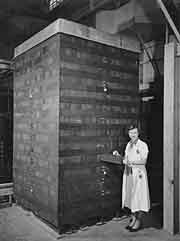 |
| In a 1946 photo, Estabrook is shown at one of her research areas at the Graphite Reactor. This stack was nicknamed “Pinky’s Pile” because she supervised its building and because of her red hair. |
It was during her two-year stint at Y-12 that the first atomic bomb was dropped on Hiroshima on Aug. 6, 1945. “When the news spread throughout the plant, and we realized exactly what role we had played in helping to end the war, everyone just went wild,” she recalled. “Workers left the plant and went into the city, where there was mass bedlam. Cars were honking and people were milling in the streets.” She was single at the time and living in a women’s dormitory. Estabrook remembers having to get out of the way of men and children running through the dorm hallways yelling the news.
In 1946, she moved on to the laboratory to take a position as a junior physicist. Over the years, she worked with such notable researchers as Alvin Weinberg, Art Snell, Walt Jordan, E. P. Blizzard, Larry Meem, Sam Beall and Doug Billington. She remained at ORNL and worked for Fred Maienschein until her retirement in 1961. She is an honorary lifetime member of the Southeastern Section of the American Physical Society.
Estabrook’s memories also include her involvement in numerous social activities in Oak Ridge. She was a former president of the first ORNL Girls Club, an organization that sponsored the Valentine’s Dance held at the Oak Terrace Recreation Hall. She also was active in the Business and Professional Women’s Club, College Women’s Club, Y-12 Horseback Riding Club, U.S. Power Squadron, Oak Ridge Playhouse, and Smoky Mountain Hiking Club. Estabrook even found time to take art lessons and night classes at Oak Ridge High School.
She also had an opportunity to sample several of the housing options of the era. After her stint in the women’s dorm, she moved to the Garden Apartments. In 1953, when she married her husband, Jack, a design engineer in the Aircraft Nuclear Propulsion Program, they moved to a D house on Orange Lane. After her retirement, they moved to Jupiter, Fla., where she still lives in a house overlooking the intracoastal waterway. Her husband died in 1968.
While a participant on the DOE Oak Ridge Facilities Public Tour last summer, Estabrook shared her World War II experiences with the tour group. As a result, she was invited to return for a special visit to the reactor during the holidays—a time she normally travels through East Tennessee to visit relatives in Kentucky.
So on December 30, Estabrook again greeted her old friend, the Graphite Reactor. When she toured her work location in Building 3001, she saw that “Pinky’s Pile” had gone away, but her memories have not. Of special interest was the “counter room,” where she spent many hours counting the activity on foils she had exposed in the reactor sources.
Her work also will be remembered through the many publications and artifacts she has preserved over the years. She shared some of those items with us in Communications and Community Outreach and with Steve Stow, director of the American Museum of Science and Energy. Copies are available in the ORNL History Room.—Marilyn McLaughlin
 Inscribed with pride
Inscribed with prideORNL’s Cray XI supercomputer is beginning to look like Willie Nelson’s guitar. A number of VIPs who have visited ORNL’s newest supercomputer have signed their names to it, including Tennessee Senators Bill Frist and Lamar Alexander, Rep. Zach Wamp, Office of Science Director Ray Orbach and Energy Secretary Spencer Abraham.
Adding a signature doesn’t necessarily require a visit to the supercomputer’s home in the Center for Computational Sciences. The Cray’s doors are removable, and last summer the front cabinet was trucked up to the Spallation Neutron Source’s front-end building, where Secretary Abraham and Sen. Alexander signed it just before they helped break ground for the Center for Nanophase Materials Sciences.
 |
| The autographed computer, with the commander-in-chief’s signature (inset). |
 |
The shell was on the road again in January, this time to an event in Knoxville. Conspicuously (and appropriately) at the top, the Cray cabinet now sports its latest autograph—George W. Bush.
The famously inscribed Cray X1 and CCS’s other computer systems can be seen from the visitor’s viewing area of the CCS computer center in the Computational Sciences Building, right off Main Street. “Stop by any time,” says the CCS’s Buddy Bland.
 HTML mates problem, solution
HTML mates problem, solution
ORNL’s High Temperature Materials Laboratory routinely works with industries toward solving challenging problems. In a recent case, the Lab played matchmaker between a firm with a problem and another with a solution.
“A North Carolina company, Porvair, came to ORNL for help in evaluating a metallic foam that the firm has developed,” says the Metals and Ceramics Division’s Edgar Lara-Curzio. “These light-weight foams have countless applications from fuel cells to filters to catalytic converter substrates.”
Around the same time the paper producer Weyerhauser approached ORNL for help with a problem with stress cracks in some of its heat-recovery equipment.
The paper manufacturing process generates a substance called black liquor. The industry recycles the black liquor by deriving gases from it. The gases are used to drive turbines.
“They do this in large metallic pressure vessels lined with refractors,” says Edgar. “The intense heat and chemical reactions, however, were causing swelling in the refractories, which stressed the vessels, resulting in cracks.”
M&C Division researchers Jim Keiser and Cam Hubbard, who have worked with Weyerhauser for years, approached Edgar for ideas. He thought of Porvair’s foam.
His idea was to place the metallic foam between the refractors and the vessel wall, which would accommodate some of the swelling. Edgar wrote a proposal that called for tests of the foam and the two companies were put in contact with each other.
“The chemical reaction is time-dependent deformation,” Edgar says. “I evaluated the foam and developed an equation that predicted how much deformaton the foam would transfer from the refractory to the pressure vessel. Tests were acceptable.”
The foam was subsequently installed on a Weyerhauser system. The result is a potential six-figure deal for Porvair and six months—so far—of crack-free gasifier operation for Weyerhauser.
 Lab researchers moonlight
Lab researchers moonlight
Engineering S&T Division researchers have been working day and night for the past several years to develop hybrid lighting systems, which bring sunlight inside buildings to save energy and improve inner lighting. On a recent evening, however, the raw material was moonshine.
On a cold winter’s night well below freezing, Duncan Earl, at the Engineering Technology Facility, aimed a solar collector at the full moon. Inside, Dave Beshears basked in moonlight brought into the room by optical fibers and took data needed for design changes in the optical system.
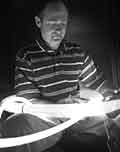 |
| ESTD’s Jeff Muhs basks in a fiber-optic glow. |
Project leader Jeff Muhs explains that the researchers needed to measure the power distribution of incoming light at a particular location in the system, but sunlight was too bright.
“Since we’re concentrating sunlight 800 times, none of our instruments could handle the amount of light being focused by the system on a sunny day,” Jeff says. “The moon is approximately the same size and shape as the sun, so Duncan got the ‘bright’ idea to do his measurement at night. This was something we had to get done and the moon was available.”
Down in the lab, Dave reported the moonglow as somewhat eerie. “I kept looking over my shoulder waiting for something to come jumping out from behind a shadow,” he says.
Jeff says the hybrid lighting team typically thinks creatively to overcome challenges. “The lab is fortunate to have people like them who love what they do and do whatever, or whenever, it takes to get the job done.”
 Names are more than games
Names are more than games
Most folks learn their way around the complex DOE Oak Ridge system after they’ve worked here for, oh, say, 5 or 10 years. For those less familiar, Oak Ridge and its myriad facilities, contractors and missions can be easily confused. That is particularly true for the news media, and the problem hit home for the Lab on New Year’s night.
CBS Evening News reported on that holiday evening that 200 keys that “provide possible access to sensitive areas” had been reported lost at ORNL, which the report characterized as a “nuclear weapons lab.” The Web version of the report described, not ORNL, but the weapons facility across the ridge.
Nevertheless, phones rang at ORNL. Local CBS affiliate WVLT, realizing that the network had gotten the “who” and much of the “where” wrong, helped persuade the network to run a short, but very welcome, correction on the next evening’s newscast.
Part of the price of ORNL’s success as a research lab is that often outsiders will assume anything at Oak Ridge comes under the purview of ORNL. Sometimes it’s a minor matter. Other times, however, it matters a lot.
| —Reported by Bill Cabage |
 ‘ORNL Reborn’
‘ORNL Reborn’
Oak Ridge Arts Center mural celebrates Laboratory’s history, future
 |
| ORNL Director Jeff Wadsworth points out a carbon-60 molecule—which also resembles a soccer ball—to mural designer and guest Jane Larson. |
On a blustery afternoon in January, several dozen artists, community officials and Laboratory leaders gathered to commemorate the hanging of a special ORNL mural designed by former Oak Ridger Jane Larson.
Larson, a well-known artist who is the widow of former ORNL Director and Atomic Energy Commissioner Clarence Larson, was commissioned by UT-Battelle to design and produce the clay tile mural for the new Research Office Building. The work now hangs in the front lobby of the building, which is part of the $200 million facilities modernization project.
“ORNL Reborn” depicts ORNL’s core science competencies, including computational sciences, genomics, materials research and life sciences. Larson’s design was completed with the assistance of nearly 50 volunteers from the Oak Ridge Art Center.
ORNL Director Jeff Wadsworth, on hand to salute the artist and volunteers, called the mural a beautiful celebration of science, nature and art. “It’s wonderful to have it in our new building,” he said.
Larson, a member of the “Muddy Boot Club” for workers and family members who came to Oak Ridge in 1943, expressed her pleasure at seeing the mural on the ORNL wall. Laboratory officials became interested in Larson’s work after viewing her tile mural, “Energy and Life,” on the front of the Art Center.
The mural ceremony also marked the conclusion of ORNL’s 60th anniversary observances, which began in February 2003. Following Larson’s remarks, she received a special gift from Wadsworth—a diamond-studded version of the Lab’s popular anniversary lapel pin.
 Key appointments
Key appointments
Moves, retirements, realignments all contribute to ‘changing face of ORNL’
 |
| Hill |
David Hill, who had served as director of the Nuclear Science and Technology Division, has succeeded Gil Gilliland as associate Lab director for Energy and Engineering Sciences. Gilliland is working with Wadsworth on a special program development assignment, including some early workshops associated with the opening of the Oak Ridge Center for Advanced Studies. Joe Herndon is serving in the new position of operations manager for the E&ES directorate.
Jim Rushton, who heads the Fuels, Isotopes and Nuclear Materials group for Nuclear Science and Technology, is serving as the division’s acting director during a national search for Hill’s replacement.
 |
| Mann |
National Security Director Frank Akers is now acting manager of the Lab’s Homeland Security program, succeeding Gordon Michaels, who served in the role during the new department’s startup. A search is under way for a permanent program manager.
Fred Evans has stepped down from the position of director of the Office of Counterintelligence and plans to retire soon. Chris Marsalis is serving as interim director until a permanent replacement is appointed.
Jan Preston, who served as director of Independent Oversight, has taken a position with Battelle corporate. Independent Oversight has been combined into the Audit and Assessments directorate, with Scott Branham at the helm. Julie Ezold is leading independent oversight, and Gail Lewis leads audit and management services.
Brian Davison is the new director of the Life Sciences Division, reporting to Mann. Davison previously led the Biochemical Engineering Research group in Life Sciences. He will be responsible for leadership and program development for the entire R&D portfolio in the division and will continue his significant participation in the development of the DOE Genomics Program, also known as Genomes to Life.
Barry Berven has been appointed operations manager for the Biological and Environmental Sciences Directorate, reporting directly to Mann. Since 1997, Berven had served as the operations director for the Life Sciences Division during a time that included construction of the Russell Laboratory, the new “mouse house.”
Gary Jacobs has been named director of the Environmental Sciences Division, also reporting to Mann. He served most recently as ESD’s deputy division director and directed program development for the division. He has worked in a variety of R&D projects in carbon sequestration, environmental engineering, microbial biogeochemistry and remediation technologies. Jacobs replaces Steve Hildebrand, whose retirement was effective Dec. 31.
Cindy Kendrick will fill a newly created position as employee concerns coordinator. Her role is a response to an ORNL focus group’s call for a more centralized approach to receiving and responding to employee concerns. Kendrick will be working directly with Wadsworth to deal with concerns quickly and effectively.
 Laboratory people, programs stay in the news during 2003
Laboratory people, programs stay in the news during 2003
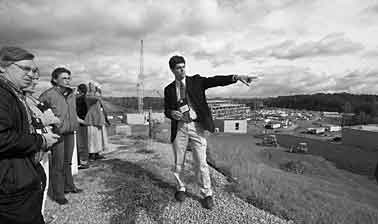 |
| Thom Mason, director of the Spallation Neutron Source, led U.S. and Canadian science writers on a tour of the project site during the New Horizons briefing in October. SNS stories appeared in the Toronto Star and The Why Files Website several weeks later. |
The appearance in the Jan. 12 issue of Time magazine by researcher Thomas Thundat (Life Sciences Division) was the latest in a long series of media mentions of ORNL projects and staff members during recent months.
Thundat was featured in a special section on sensors titled, “Beyond the Sixth Sense.” Time’s article described his serendipitous discovery of the microcantilever effect and featured a photo of Thundat seemingly levitating between a couple of flat-screen monitors.
Another media-related highlight occurred in October, when ORNL co-hosted the Council for the Advancement of Science Writing’s New Horizons Briefing with the University of Tennessee. The annual event brings together distinguished scientists from a host of disciplines to meet with science writers and other journalists from a variety of media outlets.
On the ORNL campus the writers visited the Aquatics Research Center, the Science Exploratorium and the Spallation Neutron Source site. They also saw a demonstration of the heat-conducting properties of graphite foam. Some 200 persons participated in the event, including media representatives from numerous national and international media outlets. Science features about ORNL programs later appeared in several of the publications and broadcast media represented at the briefing.
And there were many other national stories as well. According to statistics kept by Communications and Community Outreach staff, there were some 300 mentions of ORNL work in national and international print media during 2003. These included at least 13 appearances in The New York Times, nine in The Washington Post, three in USA Today, nine in Newsday, two in The Wall Street Journal, four in Business Week, three in Forbes, two in the Chicago Tribune, three in the Los Angeles Times, four in the Atlanta Journal-Constitution, three in the Miami Herald, two in the Philadelphia Inquirer, three in the San Francisco Chronicle, four in the New Orleans Times-Picayune, two in the Baltimore Sun, four in the Kansas City Star, two in the Toronto Star, two in Popular Science and 31 on the Associated Press wire.
Other national or international publications of note carrying at least one ORNL story in 2003 included the Boston Globe, Dallas Morning News, U.S. News & World Report, Vancouver Sun, Sydney Morning Herald, Popular Mechanics, National Geographic and Scientific American.
Television coverage of ORNL activities also was heavy during 2003. Several stories appeared in the national broadcast media, including at least three on ABC News, two on MSNBC and one each on CNN Headline News and Fox News. Knoxville affiliates WATE, WBIR, WVLT and WTNZ carried more than 200 stories related to laboratory activities or people, and stations in Nashville, Chattanooga and Memphis combined for more than 30 stories about ORNL.
Laboratory programs were featured frequently in trade media as well. Communications and Community Outreach staff tracked more than 240 ORNL items in national and international trade publications during the year. Most frequent appearances were in Inside Energy (30), Science Daily (9), New Technology Week (8), Small Times (6), Biotech Week (5), Wired News (5), Science (3), Bioterrorism Week (3), Advanced Materials & Composites News (3) and the United Kingdom’s The Scientist (3) and Electronics Weekly (3).—Cindy Lundy
 Boys Club, other programs to benefit from UT-B corporate gifts
Boys Club, other programs to benefit from UT-B corporate gifts
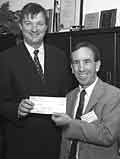 |
| One from the holidays: Lab Director Jeff Wadsworth hands a check for the Knoxville News Sentinel’s Empty Stocking Fund to NS editor Jack McElroy. |
The UT-Battelle corporate giving program continues to make a difference in the lives of the less fortunate in our communities.
Funding is being provided, for example, to the Oak Ridge Boys Club to support several building and remodeling projects. In recent years, company donations have been used to make the club safer, improve the student support center and fund other improvements.
During the holidays, a donation was made to the Knoxville News Sentinel’s Empty Stocking Fund. This program has provided Christmas baskets to needy families in East Tennessee since 1912.
Support also is being provided to the Methodist Medical Center for its CALM House. This facility, together with the MMC’s Hospitality House, will serve as a home away from home for the families of critically ill patients.
UT-Battelle supports projects in the areas of science and math education, economic development, civic programs, and the arts. If you have questions about the corporate gifts program, contact Brenda Hackworth, hackworthbt@ornl.gov, (865) 241-7249.
 ORNL people
ORNL people
Human Resources and Diversity Programs’ Mike Willard, who has just completed a term as president of the Tennessee Valley Human Resources Association, has begun serving on the TVHRA board of directors. He also will serve as the East Tennessee representative to the Society for Human Resource Management, of which TVHRA is the local chapter.
A new book, Ceramic Nanomaterials and Nanotechnology II, co-edited by ORNL staff member Michael Z. Hu, has been published by the American Ceramic Society. Hu, an engineer in the Nuclear Science and Technology Division, also has been elected liason director (two-year term) for the executive committee of the Nanoscience and Engineering Forum for the American Institute of Chemical Engineers.
Procurement’s Al Guidry, two-term outgoing president of the Atomic City Sportsmen Club, Inc., was named the organization’s “2003 Sportsman of the Year,” for his volunteer community involvement. Guidry was presented the award at the 16th Annual MLK Celebration Breakfast in January.
Becky Kendall, a quality manager and quality assurance specialist in the Quality Services Division, recently met the requirements and demonstrated the knowledge required to be recognized as a certified quality engineer by the American Society for Quality. She supports the Facilities and Operations and Human Resources and Diversity Programs organizations as their quality professional.
Life Sciences Division’s Frank Larimer of the Genome Analysis and Systems Modeling Group and his colleagues recently published their work on Rhodopseudomonas palustris, “a purple photosynthetic bacterium that coordinates and expresses its many metabolic capabilities in response to changing environmental conditions,” in Nature Biotechnology. In addition, one of their illustrations graced the cover of the issue. One of the first genomes of anoxygenic photobacteria finished, R. palustris is the subject of several large research projects sponsored by DOE’s Office of Science under the umbrella of the Genomes to Life program.
ORNL Corporate Fellow Tom Wilbanks has been designated a lifetime “National Associate” of the National Academies, “...in recognition of extraordinary service to the National Academies in its role as advisor to the nation in matters of science, engineering, and health.” Also listed in the 2003 Directory of National Associates are David Greene of Engineering Science and Technology and former ORNL Director Alvin Trivelpiece.
 Small Business Program Office wins SBA award
Small Business Program Office wins SBA award
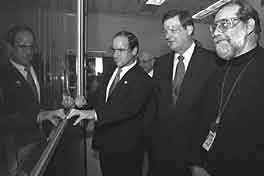 |
| Third District Rep. Zach Wamp (left) came to the Lab in early January. Among technologies he saw with Lab Director Jeff Wadsworth and researcher Ted Huxford (right) was a demonstration of the use of the Metals and Ceramics Division’s plasma arc lamp for security applications. |
The Small Business Administration has presented its Award of Distinction to ORNL’s Small Business Program Office.
Will Minter, ORNL’s small business program manager, was commended for his efforts in strengthening the program.
“Will plays a significant role in promoting opportunities for small businesses at ORNL,” said Liz Hopewell, SBA’s associate administrator for government subcontracting, in a letter to Lab management. “His efforts have produced significant results.”
The award was initiated in 1985 as a way to recognize large federal contractors that have exceptional small business subcontracting programs. Fewer than two percent of SBA’s portfolio of large contractors have earned this award.
Minter noted that the ORNL award was earned as a team effort. “We have earned this award because of the dedication shown by this Laboratory’s procurement organization and other staff throughout ORNL,” he said.
 Berven, Pinnaduwage, Thundat among Life Sciences’ achievers
Berven, Pinnaduwage, Thundat among Life Sciences’ achievers
The Life Sciences Division recently presented its annual achievement awards. The award winners for 2003 are
Distinguished Achievement—Barry Berven, for leadership of the Life Sciences Division during a critical period, during which he helped the Mouse Genetics program reach a capability for further work through two critical new areas: completion of the Russell Laboratory for Comparative and Functional Genomics and the outsourcing of ORNL animal care.
Scientific Achievement—Lal Pinnaduwage and Thomas Thundat, in recognition of pioneering research on microcantilever-based explosive sensors, which resulted in a number of prestigious publications, including one in Nature.
Management Achievement—Bob Ross, in recognition of continued and sustained leadership in the Toxicology and Hazard Assessment Group, where he has successfully marketed, cultivated and maintained new and existing non-DOE sponsors in competitive times and utilized the expertise of his staff to ensure milestones were met with quality.
Administrative Achievement—Patty Thompson, in recognition of her cheerful, professional service to the entire division (often in the face of almost constant complaints about the “system”), while assuming responsibility for a number of new duties in the last year.
Technical Achievement—Gene Barker, in recognition of his assistance, support and facilitation of the Mouse Genetics Program’s move to the west end of ORNL, as he served as liaison between research staff, union crafts and contractors during the relocation, renovation and construction, while continuing to carry out his technical research duties.
 New Staff
Members
New Staff
Members
Zane Bell, Nuclear Science & Technology
Jae Cho, Engineering Science & Technology
Dennis Jackson and Wilson Lannom, National Security
Timothy Powers, Quality Services
Eva Rather, Contracts
Jeffery Sipes, Operational Safety Services
Herbert Woodworth, Computational Sciences & Engineering
William McDonald, Chemical Sciences
Kenneth Roche and Sergey Shpansky, Computer Science & Mathematics
ORNL office: P.O. Box 2008, Oak Ridge, TN 37831-6146, Building 4500-S, Room F-60, MS 6146
DOE inspector general hotline: 1-800-541-1625
[an error occurred while processing this directive]
[an error occurred while processing this directive]
Cindy Lundy, lead editor, ORNL, 865/574-1642 (lundycr@ornl.gov)
Deborah Barnes, associate editor, 865/576-0470 (barnesds@ornl.gov)
